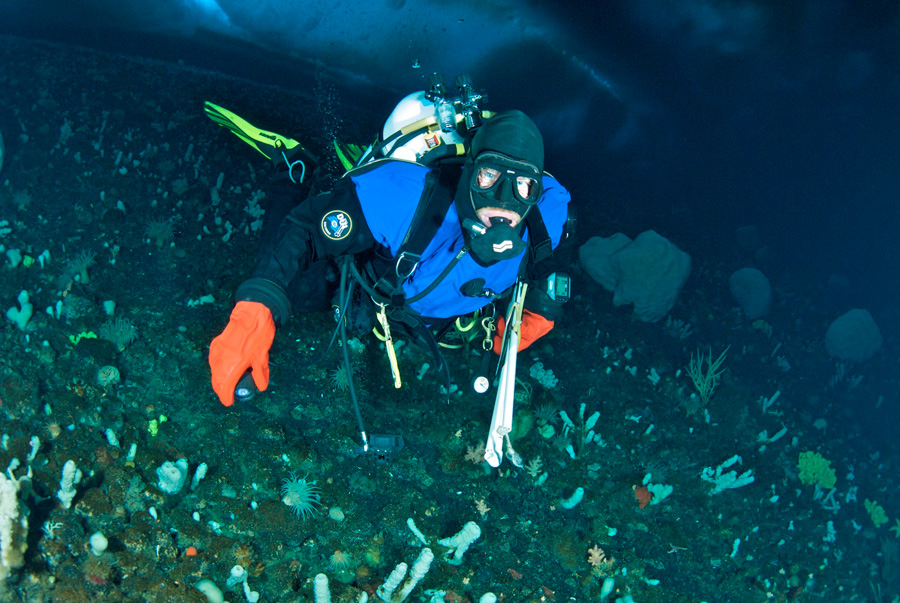
Photo Credit: Norbert Wu
|
Diver Rob Robbins swims under the sea ice in McMurdo Sound near Arrival Heights in a previous season.
|
2,000 Dives Under the Antarctic Sea
By Michael Lucibella, Antarctic Sun Editor
Posted November 25, 2015
Party balloons greeted Rob Robbins as he climbed out of the icy waters of McMurdo Sound on October 22. The colorful additions to the typically utilitarian furnishings of the small dive hut marked a major milestone in his career.
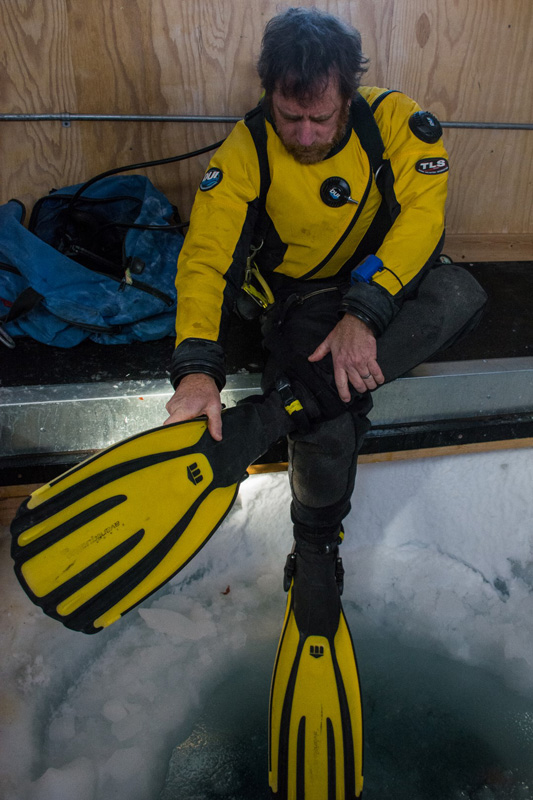
Photo Credit: Michael Lucibella
Perched above a hole in the sea ice, Robbins dons his fins before a dive.
He had just completed his 2,000th scuba dive in Antarctic waters. It was a significant career milestone for a man who last year was named the recipient of the prestigious Conrad Limbaugh Memorial Award for Scientific Diving Leadership by the American Academy of Underwater Sciences.
“We threw a mini-woohoo,” he said nonchalantly.
His modesty aside, it’s a huge number of dives, by far the most in the program. As the dive supervisor for the National Science Foundation-managed U.S. Antarctic Program, Robbins is essentially in charge of all things underwater. One can find him immersed in the near-freezing sea most days of the week, collecting samples for researchers, repairing the station’s infrastructure or taking photos of the unique offshore life.
“As soon as you pop into the water and you get under the ice here, it’s colorful. There are tons of invertebrates. Red sponges, green sponges, lots of sea stars of various color, lots of color,” Robbins said. He gestured out at the frozen sea and mountains visible from McMurdo Station. “You look out here, it’s very stark. McMurdo is a very stark place.”
On the day of his landmark dive, he was helping a team of researchers collect tiny sea spiders off of Dayton’s Wall, a large underwater drop-off a few hundred yards offshore of McMurdo. Floating in the water column, Robbins could see the undulant seafloor stretching far out before him.
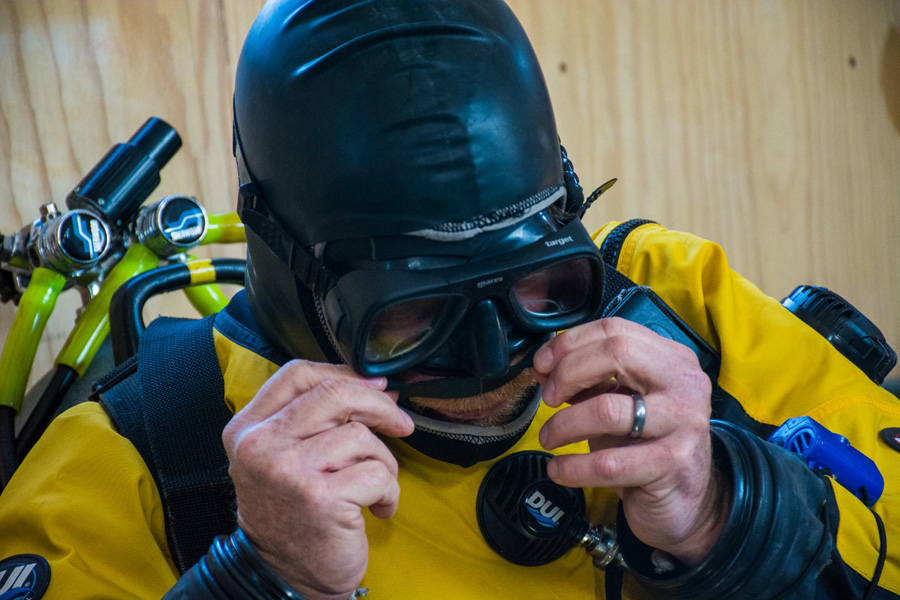
Photo Credit: Michael Lucibella
Fitting his mask into place, Robbins makes sure his equipment is in good working order before a dive.
“The visibility here is spectacular. Hundreds of feet, like nowhere else in the world really, so that makes it quite special,” Robbins said. “You see terrain. Most places you go diving you don’t see landforms but here you do.”
How the Antarctic benthos compares to the rest of the planet is something that Robbins knows quite a bit about. He’s been diving all over the world since 1974, and venturing to Antarctica for nearly as long.
“I just have always wanted to be a diver,” Robbins said. “Since I was like eight years old I remember wanting to be a diver. It’s just the thing I’ve wanted to do my entire life.”
At age 18, Robbins took a job at Johnston Island, an isolated military facility in the South Pacific about 900 miles southwest of Hawaii. Not content just to swim at the base’s pool where he was a life guard, he started scuba diving off the coast in his spare time. There he found an underwater world just like the one he had watched the French scuba pioneer Jacques Cousteau explore on television for years.
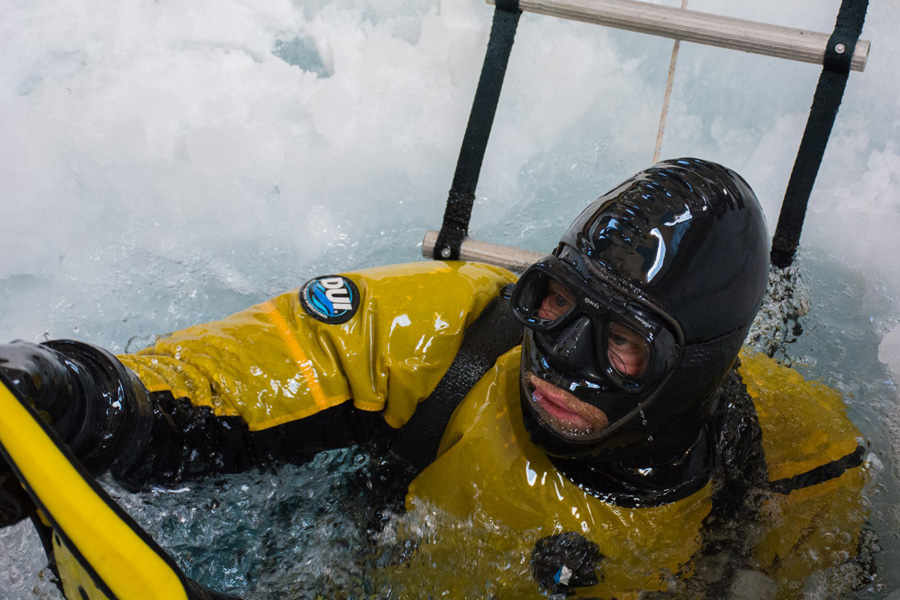
Photo Credit: Michael Lucibella
After a successful dive, Robbins emerges from the icy waters of McMurdo Sound and passes up one of his fins to the nearby dive tech.
“All the colorful fishes and corals and that kind of thing: It was just exactly what I envisioned, which was very cool,” Robbins said.
Incongruously, it was while he was surrounded by the island’s tropical climate and warm waters that the frozen continent thousands of miles to the south first started calling to him.
“When I was on Johnston Island I met a guy that had just come back from a winter at Siple station,” Robbins said, referring to the now decommissioned year-round U.S. station in West Antarctica. His friend, Larry Miyoda spent a winter at the small station with just three other people. “I got super interested in the Antarctic from him.”
It was an idea that stayed with him as he worked at Johnston Island for the next three years. With the money he saved, he attended the Florida Institute of Technology (FIT), majoring in diving technology.
“At FIT, courses generally focused on getting people to go into the oil industry, but it’s a big broad spectrum of diving education,” Robbins said.
But the Antarctic seed had firmly taken root.
“Before getting into diving, I have got to go to the Antarctic,” Robbins told himself at the time.
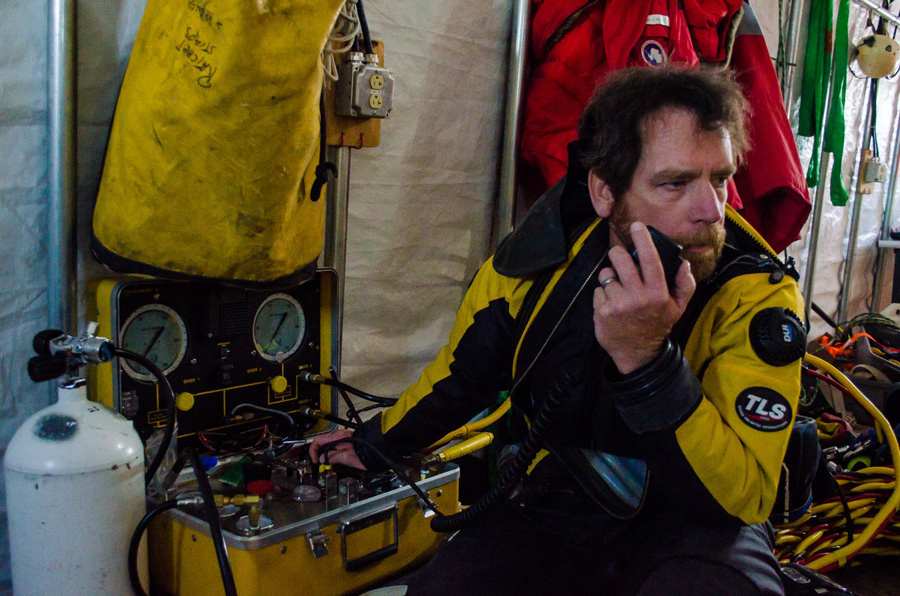
Photo Credit: Michael Lucibella
As diver Steve Rupp works underwater, Robbins keeps in touch with him through his dive helmet's intercom.
He was in luck. Holmes and Narver, the contractor he worked for at Johnston Island, was also in charge of the Antarctic contract at the time and the former resident manager of Johnston was the program manager of the Antarctic Research Program.
A few phone calls and several rounds of interviews later, he was hired as a general assistant at McMurdo Station for the 1979 summer season. His primary duty was running various administrative odd jobs out of the National Science Foundation’s office in the Chalet, but he ended up working a lot with the outdoor gear distributors at the Berg Field Center (BFC).
After the end of the austral summer, he move to Louisiana and started splitting his time between Antarctic operations and commercial scuba diving. He spent his off seasons in the Gulf of Mexico, usually diving for one of the major oil companies in the region.
“Mostly the jobs I was on was setting oil rigs,” Robbins said. He would use underwater jets to bury underwater pipes and torches to trim excess steel off of pylons holding up oil rigs.
He returned to the Antarctic and over the next few years, worked a number of different positions around the program. He spent a season as the assistant manager of the BFC, then a winter as its manager, followed by a stint at Palmer Station in charge of its boats before returning to McMurdo as the full-time head of the BFC, which he held for three years.
“I wasn’t quite done with the program,” he said. “There was a chance to run a field camp on Seymour Island out on the Weddell Sea, so I did that for a season.”

Photo Credit: Michael Lucibella
After a successful dive, Robbins drives his PistenBully back to the station across the sea ice.
He spent the next season as the station manager of Palmer Station, which he originally planned on being his last in Antarctica. However a problem with the station’s water treatment system presented him the opportunity to really fuse his two passions.
“While I was there, there were issues with the seawater intake,” he said. It needed a lot of work to replace, and underwater pipes were something he had a lot of experience with from working in the Gulf. “I’m a diver by trade, so I’ll just do this diving at Palmer, and then I’ll be done.”
At the time, several major underwater construction projects were starting at both Palmer and McMurdo. He had done some diving a few years earlier at Palmer, but this was the chance to make it his priority.
“I started doing the diving stuff exclusively then,” Robbins said. “That’s the first time I really got very involved with the divers.”
After more than almost ten years of underwater welding and laying foundations, the construction work was wrapping up, but diving for science was becoming a bigger, more integral part of the research done at both Palmer and McMurdo.
“We’d done all the construction stuff that needed to be done, but I think that they didn’t really want to lose the capability of having construction diving,” Robbins said. “So they decided to meld the science diving and construction diving together.”
Robbins took charge of overseeing all diving in the program. The science side is now bigger than ever, making up the majority of his underwater work.
“Most of the science diving for us really is [scientists] come down and say, ‘We need a hundred urchins, we need this instrument deployed, we need some video.’ So they tell us what they need and we help them do it or we do it for them,” Robbins said.
He said receiving last year’s award was an honor, but what keeps him strapping on his scuba tank for one more dive is a deep love for what he gets to do every day.
“I don’t think I’ve had a single dive here that I wasn’t thinking ‘Wow, this is super cool.’”










